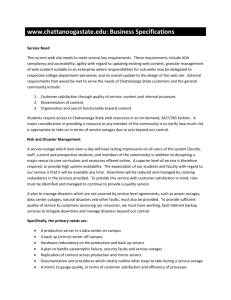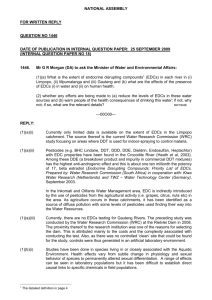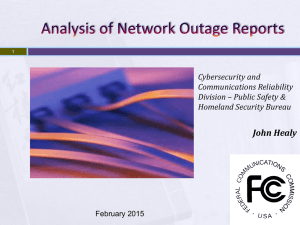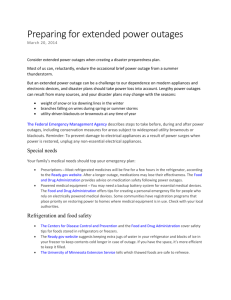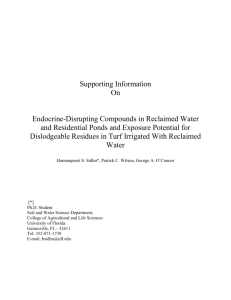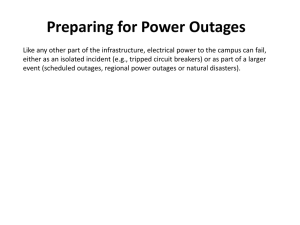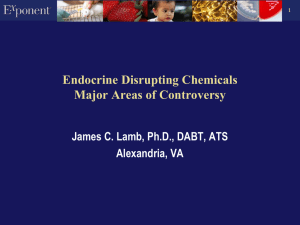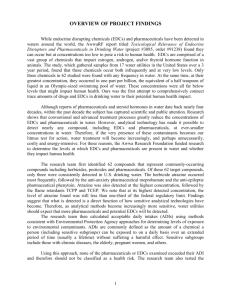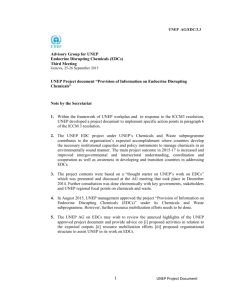PUC Action Items - Public Utility Commission
advertisement
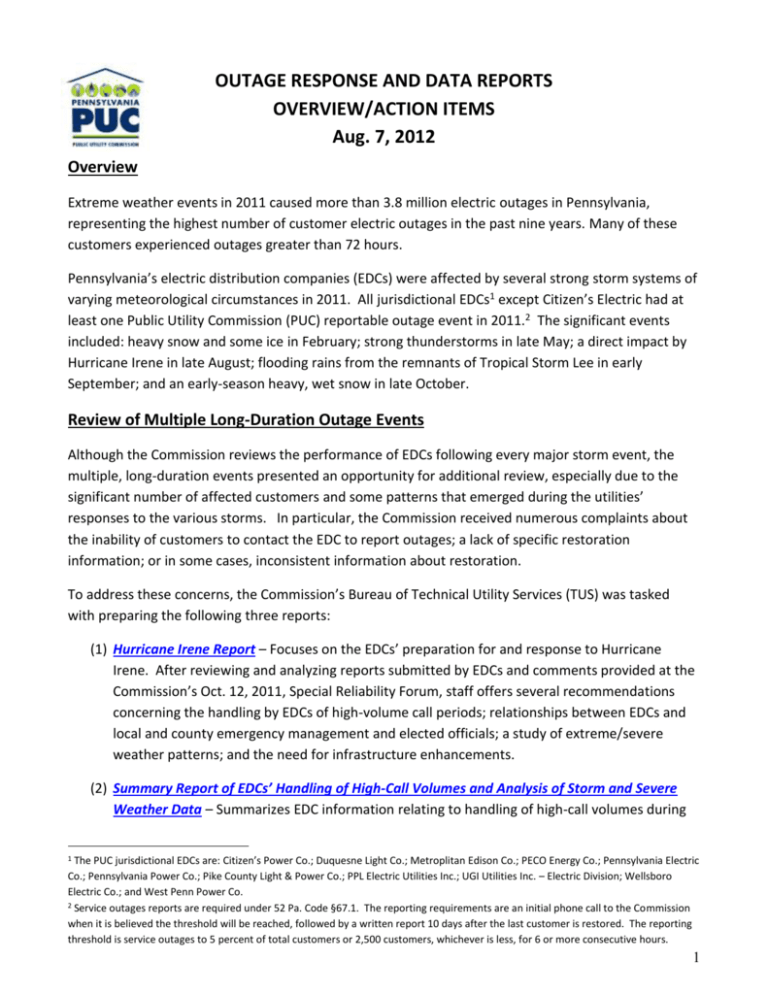
OUTAGE RESPONSE AND DATA REPORTS OVERVIEW/ACTION ITEMS Aug. 7, 2012 Overview Extreme weather events in 2011 caused more than 3.8 million electric outages in Pennsylvania, representing the highest number of customer electric outages in the past nine years. Many of these customers experienced outages greater than 72 hours. Pennsylvania’s electric distribution companies (EDCs) were affected by several strong storm systems of varying meteorological circumstances in 2011. All jurisdictional EDCs1 except Citizen’s Electric had at least one Public Utility Commission (PUC) reportable outage event in 2011.2 The significant events included: heavy snow and some ice in February; strong thunderstorms in late May; a direct impact by Hurricane Irene in late August; flooding rains from the remnants of Tropical Storm Lee in early September; and an early-season heavy, wet snow in late October. Review of Multiple Long-Duration Outage Events Although the Commission reviews the performance of EDCs following every major storm event, the multiple, long-duration events presented an opportunity for additional review, especially due to the significant number of affected customers and some patterns that emerged during the utilities’ responses to the various storms. In particular, the Commission received numerous complaints about the inability of customers to contact the EDC to report outages; a lack of specific restoration information; or in some cases, inconsistent information about restoration. To address these concerns, the Commission’s Bureau of Technical Utility Services (TUS) was tasked with preparing the following three reports: (1) Hurricane Irene Report – Focuses on the EDCs’ preparation for and response to Hurricane Irene. After reviewing and analyzing reports submitted by EDCs and comments provided at the Commission’s Oct. 12, 2011, Special Reliability Forum, staff offers several recommendations concerning the handling by EDCs of high-volume call periods; relationships between EDCs and local and county emergency management and elected officials; a study of extreme/severe weather patterns; and the need for infrastructure enhancements. (2) Summary Report of EDCs’ Handling of High-Call Volumes and Analysis of Storm and Severe Weather Data – Summarizes EDC information relating to handling of high-call volumes during 1 The PUC jurisdictional EDCs are: Citizen’s Power Co.; Duquesne Light Co.; Metroplitan Edison Co.; PECO Energy Co.; Pennsylvania Electric Co.; Pennsylvania Power Co.; Pike County Light & Power Co.; PPL Electric Utilities Inc.; UGI Utilities Inc. – Electric Division; Wellsboro Electric Co.; and West Penn Power Co. 2 Service outages reports are required under 52 Pa. Code §67.1. The reporting requirements are an initial phone call to the Commission when it is believed the threshold will be reached, followed by a written report 10 days after the last customer is restored. The reporting threshold is service outages to 5 percent of total customers or 2,500 customers, whichever is less, for 6 or more consecutive hours. 1 major storms and corrective actions that are currently underway or completed. The chief finding from the Hurricane Irene report determined that communications problems exacerbated customer frustrations. The report also addresses the need to focus on the increase in severe weather events and whether infrastructure improvements are necessary. (3) Summary Report of Outage Information Required by Nov. 11, 2011 Order at Docket No. I2011-2271989 – Summarizes outage information submitted by the EDCs for the period from May through November 2011 on full or partial circuit outages greater than 24 hours; between 24 and 48 hours; greater than 48 hours to 72 hours; and greater than 72 hours. It also considered circuits that were among the worst performing 5 percent of circuits identified in the PUC-filed Quarterly Reliability Reports for the first three quarters of 2011. In this report, staff in TUS recommended various studies and corrective actions by EDCs related to vegetation management trimming cycles and other potential outage mitigation measures such as strategic installation of automatic distribution circuit reclosers and sectionalizers. PUC Action Items The PUC understands the concerns of residents who were without power for many days, especially as they tried – with little or no success – to get information from their electric utility. The PUC takes each storm incident seriously and makes changes to our regulations and procedures to minimize future storm impacts. The PUC met with all affected utilities individually and during the Oct. 12, 2011, Special Reliability Forum to discuss what worked, what didn’t and next steps. The PUC continues to evaluate the data that is being provided from the EDCs and the following is a summary of the PUC’s actions to date related to long-term outages: Promulgated additional regulations designed to improve utility responses to outages; Finalized a policy statement on best practices that electric utilities should utilize to ensure effective communication during service outages, including the use of social media and new technology to keep customers informed; Incorporated sections into the annual PUC Electric Reliability Report that discuss EDC major event response and our evaluation of such; Changed the format of the PUC’s annual Summer Reliability Meeting to include EDC information on preparations for the summer storm season as well as required all EDCs to submit summary of storm preparations and notable reliability projects; and Participated in EDC emergency planning drills and tabletop exercises. Best practices have been identified through meetings between TUS and EDCs, including: Offering trained EDC liaisons to county 9-1-1 or emergency management centers; Utilizing county emergency management communications platforms and social media for outage and restoration messaging; 2 Inviting local emergency responders and county emergency management to EDC drills and tabletop exercises; Reaching out and providing liaisons to counties during storms; and Partnering with the University of Florida, who has offered to share best practices from an infrastructure study in response to hurricanes in 2004 and 2005. The PUC is committed to ongoing action items in order to effective monitor EDC response to long-term outages such as: Monitoring of the performance of EDCs’ call centers during storm events; Conducting further reviews of staffing during storm events; Working with EDCs to determine feasibility of compiling data on the costs of storm damages to assess whether an average increase year-after-year has occurred. Ensuring implementation of the corrective actions outlined by EDCs for their worst performing circuits and evaluating that the actions are having a positive effect; and Referring EDCs who experience continual problems with adequately handling high-call volumes or issue inconsistent and inadequate restoration messages during PUC reportable storms to the PUC’s Bureau of Investigation and Enforcement. The PUC also will be undertaking the following actions: Forming a working group with stakeholders to discuss options for addressing any increase in severe weather events; Partnering with EDCs to study whether Pennsylvania is experiencing increased extreme/severe weather events and determine if recent long-term outages caused by the damage of the severe storms are limited to more remote and hard-to-reach locations of circuits and are these the same troublesome circuits that have experienced multiple long-term outages; and Studying the condition of EDC infrastructure and can it adequately hold up against increasingly stormy weather and if there is a need for storm-hardening of certain electrical infrastructure. Summary of Recommended EDC Action Items Throughout this evaluation process, Commission staff notes that the response by EDC linemen and workers was extraordinary under hazardous weather conditions and long hours. Despite their best efforts, the significant number of affected customers and the length of the outages led to the development of many recommendations. As described in the three reports in more detail, Commission Staff has developed recommendations in the following areas: (1) Handling of High-Volume Call Periods 3 EDCs need to improve their ability to handle high-volume call periods during major outage events and implement a procedure to prevent inaccurate or misleading messages about restoration during expected long-term outage events. EDCs will be required to report progress on their corrective action plans as part of their quarterly reliability reports. EDCs that experience problems adequately handling high-volume call periods or provide inconsistent or inadequate restoration messages during their next PUC reportable storm should be referred to the PUC’s Bureau of Investigation and Enforcement for further action as deemed appropriate. (2) Relationships with Local and County Emergency Management and Elected Officials EDCs need to strengthen relationships with local and county emergency management and elected officials. (3) Extreme/Severe Weather Study and Need for Infrastructure Improvements EDCs should consider the needs and vulnerabilities identified by the working group noted above when developing their Long-Term Infrastructure Improvement Plans under Act 11 of 2012. (4) Circuit Study and Vegetation Management Trimming Cycles EDCs should: Examine the service regions and circuits that experienced significant amounts of longduration outages to determine if vegetation-management trimming cycles should be expedited; Review other potential outage mitigation actions such as strategic installation of automatic distribution circuit reclosers and sectionalizers; Develop best practices and effective approaches to vegetation management and other outage mitigation methods; Work with local and county officials to help mitigate resistance to tree trimming; and Continue to implement corrective actions for the worst performing circuits and strive to complete corrective actions for worst performing circuits by the close the calendar-year quarter in which they were identified. 4

